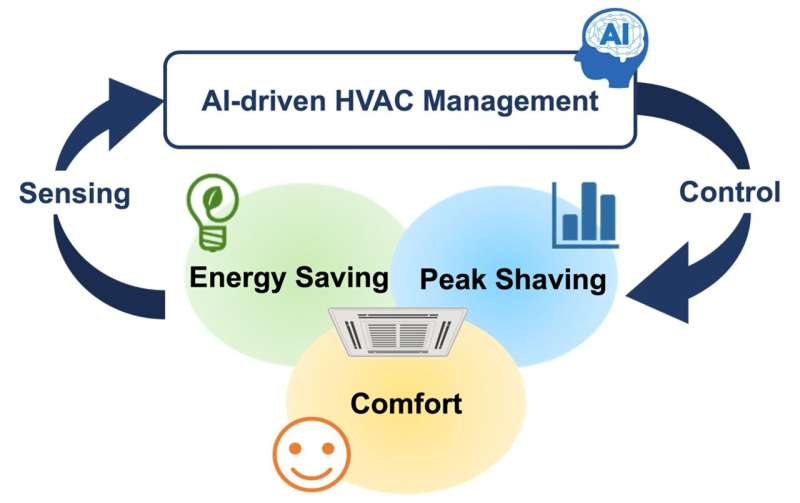This article has been reviewed according to Science X's editorial process and policies. Editors have highlighted the following attributes while ensuring the content's credibility:
fact-checked
trusted source
proofread
HVAC algorithm can provide thermal comfort for building occupants, with a smaller carbon footprint

As organizations work to reduce their energy consumption and associated carbon emissions, one area that remains to be optimized is indoor heating and cooling. In fact, HVAC—which stands for heating, ventilation, and air conditioning—represents, on average, about 40% of a building's total energy use. Methods that conserve electricity while still providing a comfortable indoor environment for workers could make a significant difference in the fight against climate change.
Now, researchers from Osaka University have demonstrated significant energy savings through the application of a new, AI-driven algorithm for controlling HVAC systems. This method does not require complex physics modeling, or even detailed previous knowledge about the building itself. The work is published in the journal Applied Energy.
During cold weather, it is sometimes challenging for conventional sensor-based systems to determine when the heating should be shut off. This is due to thermal interference from lighting, equipment, or even the heat produced by the workers themselves. This can lead to the HVAC being activated when it should not be, wasting energy.
To overcome these obstacles, the researchers employed a control algorithm that worked to predict the thermodynamic response of the building based on data collected.
This approach can be more effective than attempting to explicitly calculate the impact of the multitude of complex factors that might affect the temperature, such as insulation and heat generation. Thus, with enough information, 'data driven' approaches can often outperform even sophisticated models. Here, the HVAC control system was designed to 'learn' the symbolic relationships between the variables, including power consumption, based on a large dataset.
The algorithm was able to save energy while still allowing the building occupants to work in comfort. "Our autonomous system showed significant energy savings, of 30% or more for office buildings, by leveraging the predictive power of machine learning to optimize the times the HVAC should operate," says lead author Dafang Zhao. "Importantly, the rooms were comfortably warm despite it being winter."
The algorithm worked to minimize the total energy consumed, the difference between the actual and desired room temperature, and change in the rate of power output at peak demand. "Our system can be easily customized to prioritize energy conservation or temperature accuracy, depending on the needs of the situation," adds senior author Ittetsu Taniguchi.
To collectively achieve the goal of a carbon-neutral economy, it is highly likely that corporations will need to be at the vanguard of innovation. The researchers note that their approach may enjoy rapid adoption during times of rising energy costs, which makes their findings good for both the environment as well as company viability.
More information: Dafang Zhao et al, Data-driven online energy management framework for HVAC systems: An experimental study, Applied Energy (2023). DOI: 10.1016/j.apenergy.2023.121921
















